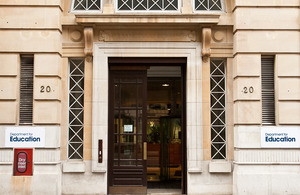Key stage 4 and key stage 5 performance tables
Details on the latest figures showing how the pupil premium is narrowing the achievement gap between disadvantaged pupils and their peers.

-
Gap between poorest pupils and their peers at lowest for 5 years.
-
Heads and teachers respond to tough new floor standard.
-
Sponsored academies’ improvement in GCSEs outstripping other schools.
Secondary school performance statistics published today reveal how government reforms are raising standards across the board.
They show how introducing tougher floor standards, giving greater freedom to heads and teachers, accelerating the academy programme, the pupil premium, and encouraging take-up of key academic subjects is driving improvement in education.
The gap between pupils on free school meals and all other pupils achieving 5 or more A* to C GCSEs, including in English and maths, is at its lowest for 5 years. More than a third of pupils (36.3%) on free school meals achieved the key indicator, against 62.6% of all other pupils.
Schools Minister David Laws said the narrowing of the gap was encouraging, and said the introduction of the pupil premium - worth a total of £1.87 billion, or £900 per pupil, in the academic year 2013 to 2014 - would help reduce it further.
The 5 local authorities with the narrowest gaps in free school meals in the main indicator are all in London: Kensington and Chelsea (gap of 3.4%, 16.4% pupils of free school meals in the borough); Tower Hamlets (5.4%, 55.1%); Westminster (7.5%, 36.2%); Lambeth (9.8%, 32%); and Southwark (10.7%, 33.9%). However, the gap in Southwark, though one of the lowest, has widened.
The 5 local authorities with the widest gaps are: Buckinghamshire (42.6%, 5.8%); Southend-on-Sea (42.2%, 11.8%); Wokingham (41.6%, 5.1%); Warrington (41.2%, 8.7%); and Sutton (39.7%, 7.6%).
The figures also show how academy sponsors are dramatically turning around the under-performing schools they take over.
The secondary school performance tables show that standards are rising in sponsored academies at a record rate - and more than 5 times as quickly than in all state-funded schools.
Across all state-funded schools, the proportion of pupils who achieved at least five good GCSEs (including in English and maths) rose by 0.6 percentage points. In sponsored academies, the increase was 3.1 percentage points.
The change in the number of schools below the floor also illustrates how many heads and teachers - in all state-funded schools - are responding to the new firm but fair floor standards introduced by the government.
A school is below the floor if 40% of its pupils do not achieve at least 5 GCSEs at C or better including English and maths, and if pupils’ progress is not good enough in both those two subjects. Last year the floor standard was 35% in attainment, and the progress measures.
Overall 195 secondary schools are below the floor this year, 56 fewer than last year had the floor been the same (40%). At 35%, as it was, 107 schools were below the floor.
The statistics also demonstrate how sponsored academies increasingly turn to academic subjects once they have got pupils secure in the basics of English and maths.
There was a 6 percentage point increase (to 88%) in the proportion of sponsored academies offering the EBacc - the combination of core academic subjects most valued by universities and employers.
Across all state-funded schools, 16% of pupils achieved the EBacc, up almost 1 percentage point.
Schools Minister David Laws said:
I am pleased to see the narrowing of the gap between the poorest pupils and their peers. This is encouraging - and I want to see it reduced even further. We are targeting more funding than ever before to help all children meet their full potential, whatever their background.
Through the pupil premium, schools have the opportunity to make a real difference in improving children’s life chances.
The statistics can be found in the publications section.
Notes
The pupil premium is designed to help schools improve the attainment of the poorest children, where ever they live, to help them reach their academic potential. By using the criteria for free school meals, we are able to target money directly to the most disadvantaged children.
DfE media enquiries
Central newsdesk - for journalists 020 7783 8300